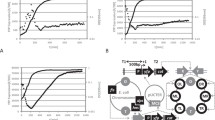Summary
Mini-F sequences, including the promoter and portions of the ccd region, were inserted upstream of lacZ in promoterless lacZ vectors, and β-galactosidase specific activities were measured. The results showed that the H (ccdA), G (ccdB) and D genes, together with a promoter, comprise an operon. Ccd operon expression was shown to be regulated at the level of transcription by the G gene product, probably in concert with the H gene product. Thus expression is autoregulated. Expression of the D gene was largely dependent on the ccd promoter, although low levels of transcription from another promoter within the ccd coding region were detected.
Similar content being viewed by others
References
Austin S, Wierzbicki A (1983) Two mini-F-encoded proteins are essential for equipartition. Plasmid 10:73–81
Bailone A, Sommer S, Devoret R (1985) Mini-F plasmid-induced SOS signal in Escherichia coli is RecBC dependent. Proc Natl Acad Sci USA 82:5973–5977
Bergquist PL, Adelberg EA (1972) Abnormal excision and transfer of chromosomal segments by a strain of Escherichia coli K12. J Bacteriol 111:119–128
Bex F, Karoui H, Rokeach L, Drèze P, Garcia L, Couturier M (1983) Mini-F encoded proteins: identification of a new 10.5 kilodalton species. EMBO J 2:1853–1861
Birnboim MC, Doly J (1979) A rapid alkaline lysis extraction procedure for screening recombinant DNA. Nucleic Acids Res 7:1513–1523
Brandenburger A, Bailone A, Lévine A, Devoret R (1984) Gratuitous induction. J Mol Biol 179:571–576
Caughey P (1986) PhD Thesis, University of Auckland, New Zealand
Francis S (1985) MSc Thesis, University of Auckland, New Zealand
Gerdes K, Rasmussen PB, Molin S (1986) Unique type of plasmid maintenance function: post segregational killing of plasmid-free cells. Proc Natl Acad Sci USA 83:3116–3120
Jaffé A, Ogura T, Hiraga S (1985) Effects of ccd function of the plasmid on bacterial growth. J Bacteriol 163:841–849
Lane D, Gardner RC (1979) Second EcoRI fragment of F capable of self replication. J Bacteriol 139:141–151
Lane D, de Feyter R, Kennedy M, Phua S-H, Semon D (1986) D protein of Mini F plasmid acts as a repressor of transcription and as a site-specific resolvase. Nucleic Acids Res 14:9713–9728
Loh SM, Cram DS, Skurray RA (1988) Nucleotide sequence and transcriptional analysis of a third function (Flm) involved in F plasmid maintenance. Gene 66:259–268
Masson L, Ray DS (1986) Mechanism of autonomous control of the Escherichia coli F plasmid: different complexes of the initiator/repressor protein are bound to its operator and to an F plasmid replication origin. Nucleic Acids Res 14:5693–5711
Maxam AM, Gilbert W (1980) Sequencing end-labelled DNA with base-specific chemical cleavages. Methods Enzymol 65:499–560
Miki T, Yoshioka K, Horiuchi T (1984) Control of cell division by sex factor F in Escherichia coli I. The 42.84-43.6F segment couples cell division of the host bacteria with replication of plasmid DNA. J Mol Biol 174:605–625
Miller JF, Malamy MH (1983) Identification of the pifC gene and its role in negative control of F factor pif gene expression. J Bacteriol 156:338–347
Miller JH (1972) Experiments in Molecular Genetics. Cold Spring Harbor Laboratory Press, Cold Spring Harbor, New York
Mori H, Ogura T, Hiraga S (1984) Prophage λ induction caused by mini-F plasmid genes. Mol Gen Genet 196:185–193
Ogura T, Hiraga S (1983) Mini-F plasmid genes that couple host cell division to plasmid proliferation. Proc Natl Acad Sci USA 80:4784–4788
Shapira SK, Chou J, Richaud FV, Casadaban MJ (1983) New versatile plasmid vectors for expression of hybrid proteins coded by a cloned gene fused to lacZ gene sequences encoding an enzymatically active carboxy-terminal portion of β-galactosidase. Gene 25:71–82
Søgaard-Andersen L, Rokeach LA, Molin S (1984) Regulated expression of a gene important for replication of plasmid F in E. coli. EMBO J 3:257–262
Sommer S, Bailone A, Devoret R (1985) SOS induction by thermosensitive replication mutants of miniF plasmid. Mol Gen Genet 198:456–464
Stoker NG, Fairweather NF, Spratt BG (1982) Versatile low copy number plasmid vectors for cloning in Escherichia coli. Gene 18:335–341
Vieira J, Messing J (1982) The pUC plasmids, an M13mp7-derived system for insertional mutagenesis and sequencing with synthetic universal primers. Gene 19:259–268
Watson LA, Phua S-H, Bergquist PL, Lane HED (1982) An Mr 29,000 protein is essential for mini-F maintenance in E. coli. Gene 19:173–178
Yang J, Pittard J (1987) Molecular analysis of the regulatory region of the Escherichia coli K12 tyrB gene. J Bacteriol 169:4710–4715
Author information
Authors and Affiliations
Additional information
Communicated by R. Devoret
Rights and permissions
About this article
Cite this article
de Feyter, R., Wallace, C. & Lane, D. Autoregulation of the ccd operon in the F plasmid. Mol Gen Genet 218, 481–486 (1989). https://doi.org/10.1007/BF00332413
Received:
Issue Date:
DOI: https://doi.org/10.1007/BF00332413



